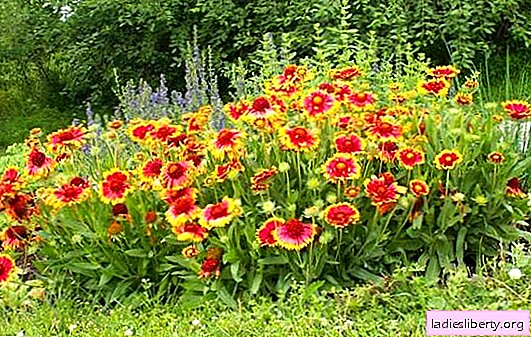
Gailardia perennial - a representative of the Astrov family. Externally, the flower resembles a camomile or daisy. The plant is very popular among gardeners, tolerates drought and is unpretentious in care. How to plant a perennial gaillardia in the garden? There are several ways to familiarize yourself with this article.
How to choose a place for planting a long-term gaillardia
Flower baskets of the plant are painted brightly, in a yellow-red color scheme. So that the colors do not fade, gaillardia is planted in open sunny areas. In the shade, flowering will not be so beautiful. Perennial varieties reach a height of about 80 cm, give them a place in the far corner of the flower garden or at the fence. Gailardia is not planted in the foreground.
After planting in one place, the shrub is grown for no more than 5 years, after which they are necessarily planted.
When choosing a site for landing a long-term gaillardia, be guided by the following recommendations:
• the place should be well lit;
• select light, well-drained soil;
• Avoid heavy soils and wetlands.
Plants will bloom from June to October only if all conditions are met.
When planting, adhere to a 35x35 cm pattern as much as possible. Remember that the shrub grows well, the root system develops rapidly. For full growth, she needs enough space.
Preparing the soil for planting a long-term gaillardia is carried out in advance. They dig it up and make mineral fertilizers. At the time of planting, only ash, rotted compost or humus may be introduced.
Ways of planting Gaylardia perennial with photos
The bush propagates well by dividing the rhizome and seeds.
Vegetative propagation
This method is the easiest. It allows you to get a flowering instance in a short period of time. However, the rhizome should be divided into large divisions, since the formation of the bush is slow.
The best time for vegetative propagation is spring or early fall, when there are no frosts. The plant will have time to take root well and will spring to growth.

Seed propagation of gaillardia
The shrub reproduces itself spontaneously, but this should not be allowed, as sooner or later varietal characters will disappear. To collect seeds, leave only the largest baskets. After they wither, wait for the seeds to ripen, cut them out and dry them at home.
Gailardia seeds are sown in spring on a pre-prepared garden bed. Seeds do not need to be buried, you can just sprinkle them on the surface of the soil and slightly press down. To accelerate germination, crops are covered with material to create a greenhouse effect. Sprouts will appear only after 14-20 days. Dive them to a permanent place is better in early summer, autumn or next spring. Such a plant will bloom only after a year.
Gailardia can be grown in seedlings. To do this, fill the containers with nutritious soil, distribute the seeds and cover with a film. The greenhouse is removed to the brightest place, where the temperature is maintained at 23 C. As soon as the shoots appear, the greenhouse is removed, allowing the plants to breathe. Seedlings dive into separate containers when a second true leaf appears.

Advice! Picking and transplanting to a permanent place is carried out by the method of transshipment, being careful not to damage the root system of the plant.
How to care for long-term gaillardia after planting
Caring for gaillardia is very simple, even a novice gardener will cope with this. Since the plant belongs to drought-tolerant species, it should not be watered too much. But leave in the sunshine without watering, too, should not be. Regular but moderate watering is optimal.
The bush treats fertilizing well and will thank it with beautiful flowering. Experienced gardeners recommend fertilizing the gaillardia three times per season:
• during tying buds;
• during flowering;
• in the middle of autumn, before frosts.
Mineral fertilizers and compost are used for top dressing, but fresh manure is not introduced.
Keep in mind that gailardia is a rather fragile plant, so it should be protected from strong gusts of wind. To do this, establish a support or plant irises and other large plants nearby.
The flower tolerates frosts well, but in snowless winters it is better to cover it with dry foliage or spruce branches.
Pest and Disease Control
Gailardia is often affected by fungal diseases, especially in rainy summers. Control the soil moisture level and regularly loosen the soil around the bushes.
Sometimes the foliage of the shrub is affected by gray rot, characteristic spots are visible on it. If not many plants are infected, then the diseased foliage is removed, and the bush is treated with a solution of potassium permanganate. If the lesion has become widespread, it is better to spray with fungicides.
Of the harmful insects, thrips, whiteflies, aphids and grinders are most often found on gaillardia. Be sure to treat the shrub with chemicals.
Popular varieties of Gaillardia
Among the shrubs there are annual and perennial varieties, the care of which is not difficult.
• Gaylardia beautiful - shrubs up to 50 cm tall, baskets 7 cm in diameter. In the middle of the flower, the color is purple, and yellow in the cuts. Flowering of the bush continues throughout the summer, after which many seeds are formed. Germination is good.
• Gaylardia spinosa - a large-flowered variety of shrubs, quite unpretentious in care. The stem is erect, well leafy. Inflorescences in diameter of about 12 cm, bright yellow-red. Flowering begins in June.
• Hybrid gailardia - this variety is derived from the previous ones. Shrub with terry baskets, the color of which is yellow-brown. The height of the bush reaches 80 cm, but today border varieties are also bred.
Use the bush in group plantings or in solitary. Gailardia looks good with daisies, irises, a nyvyanik or on a green lawn. Tall varieties are grown for cutting.
To summarize
Remember that gaillardia does not tolerate shade, prefers sunny areas and light soil. It is not necessary to grow it on wetlands. High soil moisture leads to wetting and freezing.
Pay special attention to soil treatment before planting, dig and fertilize in advance. Do not use manure for top dressing.
As you can see, landing and caring for gaillardia for many years is uncomplicated. This plant is unpretentious, but it must be transplanted at least 1 time in 5 years.











